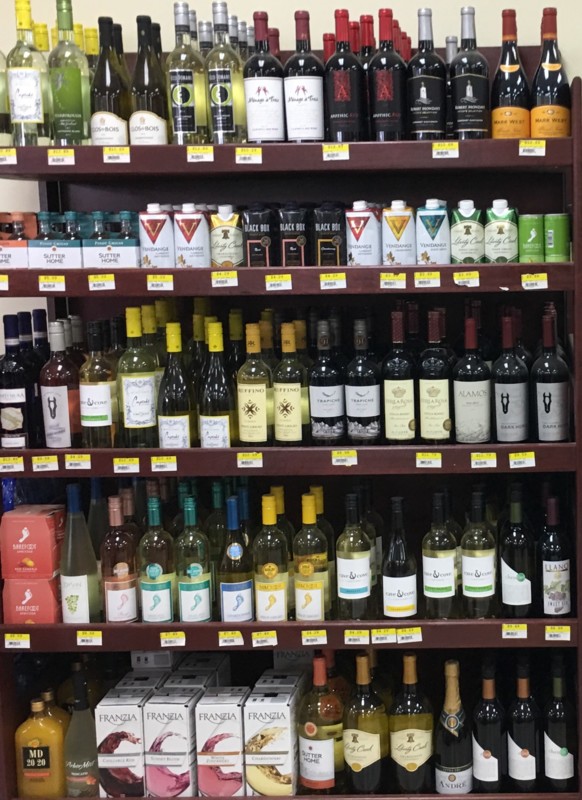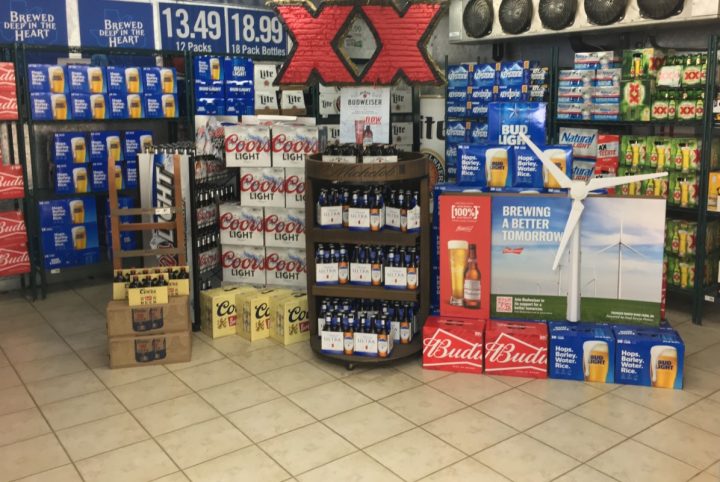
The beverage alcohol aisle in convenience stores was once the sole province of beer, and was largely overlooked by wine and spirits companies. But that scenario has changed significantly over the years. Today’s c-stores have reinvented themselves as more upscale, high-margin venues, and major suppliers now see them as worthy accounts, providing quick-transaction alternatives to rival retail outlets. In addition, revised laws in some states now permit expanded wine and beer sales in c-stores, and even the coveted millennial demographic is now showing an increasing propensity for shopping at them.
Accordingly, c-stores have been boosting and premiumizing their wine and spirits SKUs significantly. Plaid Pantry, which operates 108 stores in Oregon and Washington, revamped its wine section last year. “We gave wine a little more space and better positioning in the store,” says CEO Jonathan Polonsky. A key part of that move was an expanded offering of wines retailing between $10-$20 a 750-ml. After the makeover, Plaid Pantry showed record wine sales in eight of the following nine months. The enhanced focus has also coincided with increased efforts by local wineries and breweries to have their products sold at the chain. “They beat the doors down,” Polonsky adds.
The 150-unit Yesway convenience chain, meanwhile, has such a vast selection of wine and spirits that they’ve even received the occasional bottle of Pappy Van Winkle Bourbon, according to senior vice president of merchandising and procurement Derek Gaskins. Some of the chain’s large-footprint stores in South Dakota devote 5,000-8,000 square feet to beverage alcohol. “They’re some of the best wine and spirits sets I’ve ever seen,” says Gaskins. In total, about 70 Yesway stores in Iowa, South Dakota, Wyoming, Kansas, and Missouri offer beer, wine, and spirits, with even more selling beer and wine in Oklahoma, Texas, Nebraska, and New Mexico.

In Blowing Rock, North Carolina, the single-unit Blowing Rock Market has developed such a good reputation for its wine selection that it provides a delivery service for local customers. “We serve as their local wine store,” explains owner David Barker, noting that in the seven years he has owned the venue—which is located not far from the Blue Ridge Parkway tourist destination—he has expanded his wine selection from 300 to 700 labels, retailing at an average price of $14 a 750-ml. Barker has also grown the store’s craft beer selection from just 20 SKUs to 2,000, generally priced $8-$17 a 6-pack of 12-ounce cans.
Mammoth Footprint
According to the National Association of Convenience Stores (NACS), the mammoth convenience store channel—which tops more than 150,000 stores in the U.S.—outnumbered grocery, drug, and dollar stores in 2018, where they combined for a total of 123,000 locations. And despite the channel’s 1% decline in units last year, fueled by chain mergers and acquisitions, c-stores remain a growing presence. In the last two decades, the U.S. c-store count has risen by 28%.
For beverage alcohol marketers, the growth in c-store units has been buttressed by the loosening of license restrictions in some states in recent years. Tennessee c-stores, for example, gained the right to sell wine three years ago, while sales of strong beer (above 9% abv) and wine in Oklahoma supermarkets and c-stores commenced in 2018. This year, Colorado began permitting sales of beer in groceries and c-stores, and Kansas removed its prohibition of strong beer sales (up to 6% abv) in the outlets. Effective November 1, 2019, Utah will allow c-stores to sell beers containing up to 5% abv.
While it has been less than a year since Oklahoma’s law went into effect, Tulsa-based chain QuikTrip is already seeing benefits. “We can now offer a lot of different beers, which has resulted in a different type of foot traffic,” says Mike Thornbrugh, manager of public and government affairs at QuikTrip Corp. The chain operates nearly 800 stores in 11 states. “We’re now seeing customers who in the past would buy gas at QuikTrip, but go to a liquor store for strong beer and wine,” Thornburgh adds. “Now they’re buying those products from us.”
As they move toward more upscale models, some c-stores now even have on-site kitchens and dine-in areas. “We’re downplaying gas these days and focusing more on in-store items,” says Blowing Rock’s Barker, noting that his venue has an on-premise license and sells wine by the glass. The more refined c-stores are in turn attracting more affluent consumers. “Demographics have shifted, and the affluent consumers at c-stores have begun to expect more than a corner gas station or food mart,” says Jon Guggino, executive vice president of marketing at Delicato Family Wines. “As convenience continues to drive purchase behavior, waiting in line at a busy grocery store for a bottle of wine becomes a deterrent if the same product can be found in a faster-service location.” Millennial consumers are also increasingly shopping in c-stores, as they’ve become attracted to the quick-service model and new amenities available.

Wine’s Expanded Role
Wine in particular is making inroads in c-stores. According to Dave Derby, senior vice president of marketing at Trinchero Family Estates, overall wine sales in the channel have surged 18% since 2015, according to Nielsen, growing more than grocery, drug, and liquor channels combined. Derby and other wine marketers are pleased with the progress the category is making. “We’re seeing more interest in wine from c-stores in the last five years and, as a result, we’ve enjoyed volume growth in the channel,” says Hal Cashman, director of brand development at Palm Bay International. C-store wine shoppers have started to trade up in price points, Derby says, generally from $7-$10 a 750-ml. to $10-$15. And they’re making headway with local wines, such as Oregon wines at Plaid Pantry and North Carolina wines at Blowing Rock.
C-store marketers and retailers are seeing opportunity for wine packaging alternatives, including single-serve options like cans, pouches, and Tetra Paks. Guggino, for example, says sales of Bota Minis—which are sold as single 500-ml. offerings—increased 8% during the 52 weeks ending January 26. Derby notes that 187-ml. bottles of Sutter Home and 500-ml. Bandit Tetra Paks are growing at double-digit rates in c-stores, and that Trinchero launched Pomelo in cans this spring. Similarly, Palm Bay recently introduced 250-ml. cans of Roscato. “We’ve found that canned wine is popular at c-stores,” says Cashman.

Canned cocktails also have a place in c-stores. Pointing to the grab-and-go tendency of c-store shoppers, Troy Gorczca, brand manager for Kahlúa at Pernod Ricard USA, notes that products like Kahlúa’s espresso-flavored Martini in 200-ml. cans have a lot of opportunity at such venues. Gorcza says the liqueur-based RTD, launched earlier this year, can be merchandised both on shelves and in coolers. Yesway’s Gaskins adds that these spirits-infused beverages are “right on trend” and agrees that spirits and wine in convenience-format packages are ideal for the channel. “I’ve been shocked by the innovation I’ve seen, including packaging,” he says.
Overall, spirits marketers are responding to increased interest from c-stores where spirits sales are permitted by law. “We’ve looked to improve our capabilities in helping c-store partners capitalize on this high-margin category,” says Dan Butkus, vice president of sales for Campari America, pointing to efforts like optimized pack size and p-o-s that fit the stores’ smaller footprints. Espolòn Tequila has received tailor-made c-store programming, Butkus adds, and sales of the brand’s products in the channel increased by triple digits last year. Yet QuikTrip’s Thornbrugh laments that spirits still suffer from “a bit of taboo” when it comes to c-store sales, noting that the chain can only offer spirits in a handful of the states in which it operates.
While beer has had a longtime presence in c-stores, craft brews have made headway in recent years. According to Todd Bollig, vice president of sales at Dogfish Head Brewery, five years ago, c-stores accounted for just 1%-2% of the company’s off-premise sales; today they represent 10%. Mike Stevens, co-founder of Founders Brewing Co., points to 19.2-ounce cans of craft beer as good trade-up alternatives in c-stores. He notes that in those sizes, Founders All Day IPA and Solid Gold lager at $2-$3 offer better margins than 16- or 24-ounce cans of mainstream domestics, which are typically priced at $1-$2.

Optimism Abounds
Beverage alcohol marketers expect c-stores to gain category share, and they advise operators to maximize the opportunity. Noting that the top ten wine brands in c-stores are priced in the $6-$12 range, Trinchero’s Derby says the overall selection should be priced between $4-$20, and that alternative wine packaging should be featured.
Other marketers note that merchandising tactics can help drive higher sales of wine and spirits. Palm Bay’s Cashman says that with the installation of fixed wine racks, c-store shoppers will know that “wine will always be there.” Delicato’s Guggino, meanwhile, suggests c-store retailers feature displays of single-serve wines to encourage incremental purchases. “Cross-merchandising with other products that today’s c-store shopper seeks can promote the category, as well as increase basket rings,” Campari America’s Butkus says. He suggests c-store retailers “capitalize on the current cocktail craze” by stocking the products needed for at-home cocktail consumption.
Guggino notes that as more states loosen the reins on laws and licensing, the convenience channel will gain prominence in the wine sector. Butkus is also optimistic. “I expect that c-stores will win in the wine and spirits space,” he says. “With the right assortment, the right pricing, and the right promotion, tomorrow’s consumer will drive market share to c-stores.”